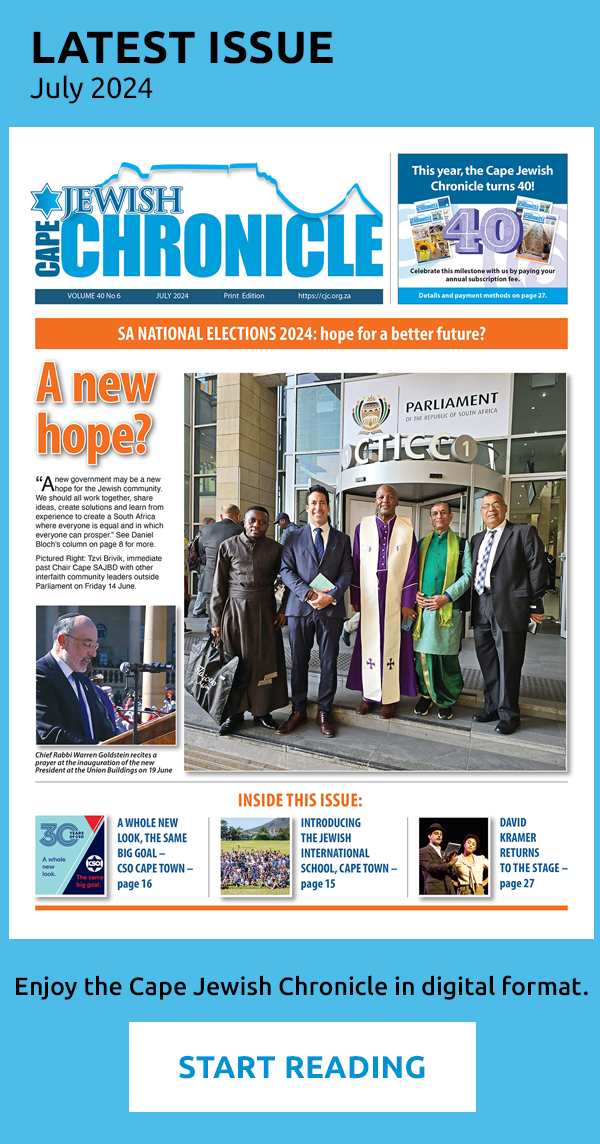By Gwynne Robins, Senior Researcher, Cape SAJBD
Unlike Caledon and Montagu, Laingsburg in the Great Karoo, a semi-desert area, had no springs, and the Buffels River which ran through the town hardly ever had any water.
The semi-arid Great Karoo was very different from Lithuania with its lakes, mud and snow, but the railways had reached there in 1878, the town had been laid out in 1881, and, with the economic opportunities this promised, some of the Eastern European Jews who had started to arrive in Cape Town from the 1880s settled there. Among the first were David and Jacob Adamstein, who established a general dealer’s store in the 1890s; Morris Cohen and Abraham Groll, a tailor, were living there in 1899; and Max and Phillip Buch, and Louis Helman, arrived in the early 1900s. David Adamstein’s leadership qualities were recognised early and in 1897 he was appointed onto the newly-formed Laingsburg Village Management Board, and then onto its local council when it became a municipality in 1904.
It did not take long for the few Jews who had settled there to reproduce a Jewish life, and by 1900 Jacob Adamstein had established the Laingsburg Hebrew Congregation with 25 members. Three years later they had acquired land for a cemetery, and opened a synagogue which the Adamstein brothers equipped with a gate and railing, Israel Zacks with fencing material, Abraham Groll with a memorial tablet and Mr Guik with siddurim and bibles.
The opening of the synagogue was quite an occasion! Rev AP Bender came down from Cape Town to inaugurate it, a general holiday was declared in Laingsburg and all the leading citizens attended the event. Their first minister, Rev AM Jacobs, was appointed in 1908 and the minister’s duties included slaughtering and kashering meat for the community, and running a cheder every afternoon for their children. In 1919 they asked the local school board to excuse Jewish children from religious classes.
Apart from cherishing their religion, the Laingsburg Jewish community established a Zionist society in 1911, which held a memorial service for Theodore Herzl, and which united in 1912 with the Laingsburg Philanthropic Society — which had donated money for a cottage to house Yemenite immigrants and provided destitute Jews who landed up in Laingsburg with train tickets. They raised money for the Palestinian Relief Fund, for Ukrainian orphans, for the JNF, the Dunam Drive and the IUA. They had a Chevra Kadisha Burial Society which bought twelve burial prayer books in 1924 — an indication of how many people there were who could attend funerals.
However, it was always a struggle to keep the synagogue going financially, and one of the problems was supplying water to the synagogue and the mikveh. The Jewish Board of Deputies was asked to help, and by 1919 they had scraped together sufficient funds to repair the windmill that supplied their water. Two years later they bought a new windmill. Sometimes it rained, and in 1920 they had to restore the rain-damaged cemetery. In 1922 they approached Standard Bank for an overdraft and in 1930, H Solomon donated money for a water tank to supply the mikveh.
The community was at its peak in the 1920s, but afterwards went steadily downhill as the wandering Jews deserted it for more promising territory. The last wedding took place in the early 1930s. There was little antisemitism in Laingsburg in the 30s.
An announcement in The Zionist Record, Friday November 15, 1946 states: LAINGSBURG HEBREW CONGREGATION WANTED SHOCHET, BAAL TEFILLAH AND TEACHER. Applications are invited for the above post. Salary £30 per month plus free house (married man preferred). Apply, giving particulars of qualifications to: THE HON. PRESIDENT Laingsburg Hebrew Congregation, Box 55, Laingsburg, Cape Town.
This must have been a last-ditch attempt because by 1947 only Abraham Groll, the chairman, and Louis Helman were attending services on Friday evenings. There was no longer a minyan or a minister, but even though there were only five families living there six years later, they still regarded themselves as a congregation.
In 1962, the municipality expropriated the shul building and Issie Pinshaw, the Cape Board secretary, came to Laingsburg to collect its four Sifrei Torah and other religious artefacts. The Sifrei Torah were given to the Herzlia School, and Somerset West and Schoonder Street Congregations. The money from the expropriation was given to the Board, with some of the funds reserved for the cemetery upkeep.
Although Laingsburg was in a semi-arid area, its soil could not retain water, so when rain did occur it drained directly into the river. On 25 January 1981, after a cloudburst to the north-east, a roaring wall of water almost 6 metres high hit Laingsburg and swept away everything in its path. Within hours the whole town was under water. Ninety percent of the houses were swept away, including the synagogue, and the cemetery was badly damaged. Two-thirds of Laingsburg’s infrastructure was destroyed, along with 184 houses, 23 commercial buildings and the town’s old-age home.
Laingsburg under flood
The flood claimed 104 lives including that of Alfred Goodman, who was drowned in his house on the bank of the river. His was the last Jewish family in the village. The Anstey family, marooned on their farm, received supplies dropped off by helicopter and the Goodman family’s garage was used by the army as a storage depot.
The Board of Deputies donated money to the mayor’s disaster fund and appealed to the Jewish community for contributions. B’nai Brith International set up its own disaster relief fund which was aimed at helping those in the areas which were affected by the floods, and Magen David Adom and the Hebrew Order of David (HOD) also collected money. The HOD funds went towards a memorial for all those who perished in the disaster — the worst flood in South Africa’s history — and a plaque acknowledging the contribution was erected at the entrance to the cemetery.
Only two tombstones were left intact, those of Philip Goodman and Devorah Bat Chaim Zwi. The Jewish Board of Deputies’ Country Communities Rabbi and the HOD repaired the graves.
Much of the information in this article comes from Jewish Life in the South African Country Communities, Volume II, researched by the South African Friends of Beth Hatefutsoth.
The Cape SAJBD’s Country Communities subcommittee looks after the cemeteries of defunct country communities. For more information, contact danielb@ctjc.co.za.
Cape SA Jewish Board of Deputies website: www.capesajbd.org, Instagram, and Facebook page.
• Published in the PDF edition of the September 2021 issue – Get the PDF here.
• Sign up for our newsletter and never miss another issue!
• Please support the Cape Jewish Chronicle with a voluntary Subscription. For payment info click here.
• Visit our Portal to the Jewish Community to see a list of all the Jewish organisations in Cape Town with links to their websites.
Follow the Chronicle: Facebook | Instagram | Twitter | LinkedIn










